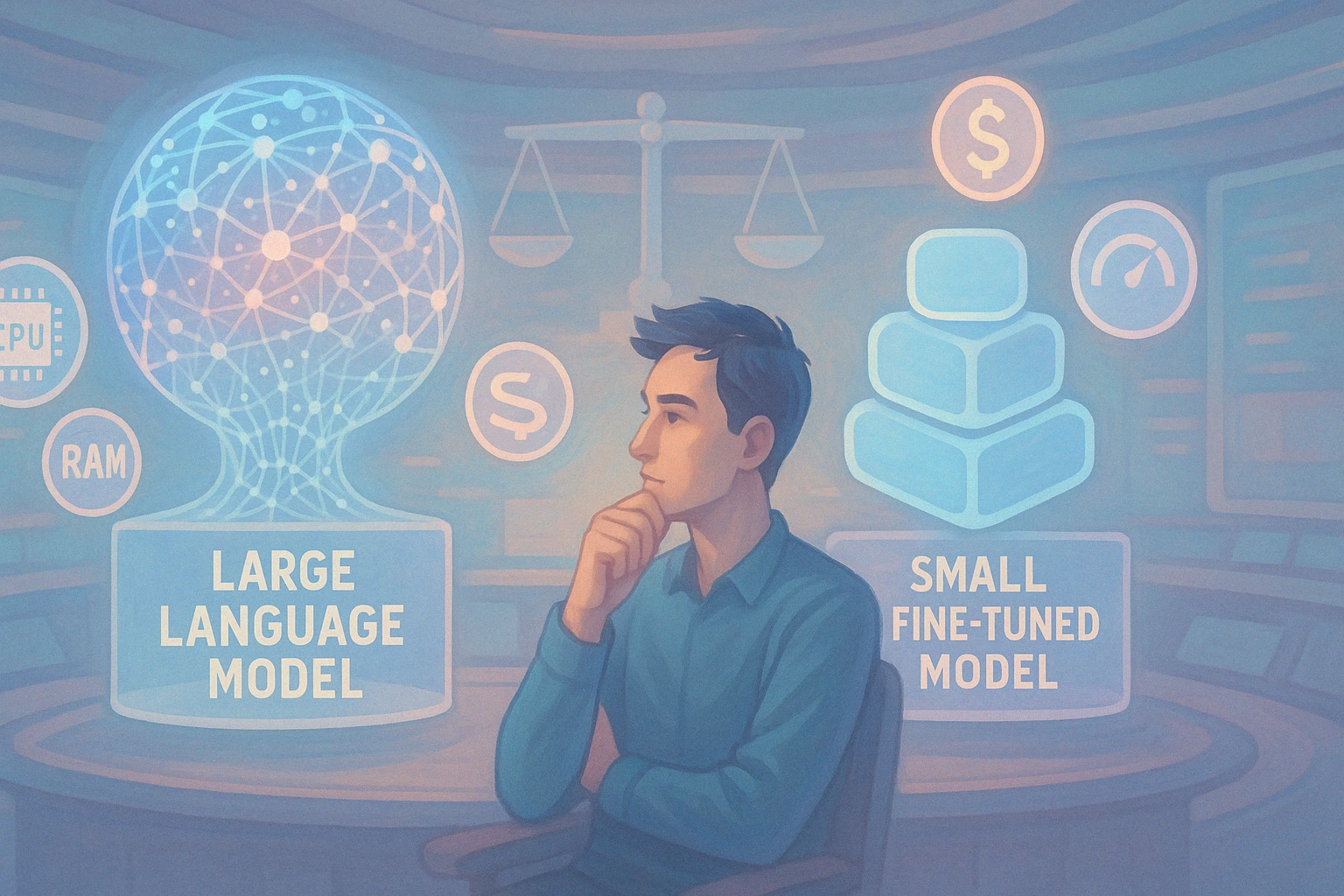
When You Need a Full Blown LLM and When a Small Model Will Also Do
Introduction
In the exciting and rapidly evolving world of artificial intelligence, there is a continuous stream of buzz and breakthroughs. One of the hottest topics is the use of Large Language Models (LLMs). These models, loaded with billions of parameters, are known for their remarkable ability to generate human-like text. Yet, while they are extraordinary in many ways, there’s a growing need to examine when you truly require a full-blown LLM and when a smaller, fine-tuned model might suffice.
With advances in fine-tuning methods like Low-Rank Adaptation (LoRA), smaller models ranging from 8 billion to 32 billion parameters can manage specific tasks with impressive efficiency. This article provides a comprehensive, easy-to-understand exploration of the trade-offs between using a full-blown LLM and opting for a smaller model. We will dive into the benefits and limitations of each, discuss resource considerations, and provide practical insights through tables, bullet points, and real-world examples.
Let’s take a friendly deep dive into this topic, exploring both the power of large models and the charm of their smaller counterparts.
Understanding Language Models: Big vs. Small
When talking about language models, size does matter—but only to a certain extent. The “size” of a model typically refers to the number of parameters it has. For instance, full-blown LLMs boast hundreds of billions of parameters, whereas smaller models might only have 8B, 16B, or 32B parameters.
What Are Full-Blown LLMs?
Full-blown LLMs such as GPT-3, GPT-4, and Google's PaLM are pre-trained on vast and diverse datasets. This enormous size enables them to:
- Grasp a broad spectrum of language nuances.
- Perform multiple tasks ranging from creative writing and answering questions to software coding.
- Handle complex, multi-domain problems with decent accuracy.
These models are typically deployed in scenarios where a high-level understanding of language is essential. However, they demand significant computational resources and extensive hardware setups.
What Are Smaller Models?
Smaller models, on the other hand, are crafted to be more resource-friendly and simpler to manage. Although they have fewer parameters, thanks to techniques like LoRA and efficient fine-tuning, they can be adapted to specific domains (e.g., customer service chatbots, medical text analysis, or legal document scrutiny) with impressive results.
The key strength of smaller models lies in their specialization. They do not aim to cover the entirety of human language but rather excel in narrowly defined areas. This makes them particularly well-suited for applications where the use case is well understood in advance.
When Full-Blown LLMs Are Necessary
There are certain scenarios where a full-blown LLM is the optimal choice. Let’s consider some common cases.
Complex, Multi-Domain Tasks
When you have tasks that span several domains or require a deep understanding of context, full-blown LLMs come into their own. For instance, legal research or comprehensive medical analysis often involves juggling multiple disciplines simultaneously. In such cases, the broad knowledge extracted from tons of data makes a massive model indispensable.
Benefits
- Broad Knowledge: The vast parameter count enables these models to cover multiple subjects effectively.
- Exceptional Accuracy: They shine when the task demands nuanced understanding that spans various fields.
- Robustness: Even with limited specific training data, these models often provide reliable results because of their extensive pre-training.
Considerations and Trade-Offs
- Computational Resources: These models require high-end GPUs or TPUs to run efficiently. This can translate to significant cost and infrastructure demands.
- Time to Train: Fine-tuning such large models can take days or even weeks, making them less suitable for rapid prototyping.
- Energy Consumption: The environmental impact and energy costs of running such extensive architectures cannot be overlooked.
Here’s a quick list summarizing the benefits:
- Extensive general knowledge
- High performance on varied tasks
- Improved accuracy on complex, nuanced subjects
For a deeper dive into the technical intricacies of full-blown LLMs, you can refer to this article on fine-tuning large language models.
Maximum Performance in High-Stakes Scenarios
When decisions are critical—think high-stakes financial analysis or autonomous decision-making systems—the margin for error is minimal. In such cases, using a full-blown LLM may not just be beneficial, it might be necessary. The robustness and performance of these models reduce the risk of errors that could lead to financial or operational losses.
Consider the following example:
-
Scenario: A multinational bank deploying an AI system to monitor trading activities is not in a position to risk inaccuracies. In such a scenario, a full-blown LLM’s comprehensive grasp of language intricacy is worth the extra computational overhead.
-
Why It Works: The model’s ability to handle ambiguity and diverse language inputs makes it highly reliable for critical decisions.
Extensive Pre-trained Knowledge
Large models usually come pre-trained on incredibly diverse datasets. This means that even if you don’t have a lot of domain-specific training data, the model can leverage what it has already learned. This is particularly useful in industries where acquiring specialized data is difficult or expensive.
Let’s break down the advantages in a table for quick reference:
| Aspect | Full-Blown LLMs | Smaller Models |
|---|---|---|
| Pre-trained Knowledge | Extensive, covering many domains | More limited, domain-specific data |
| Resource Requirements | High (requires robust hardware) | Lower (more accessible hardware) |
| Time to Fine-Tune | Longer due to complexity | Shorter for focused tasks |
| Versatility | Excellent for multiple domains and tasks | Best suited for narrow, specific tasks |
The table above clarifies the core differences, emphasizing that full-blown LLMs excel in versatility and depth of knowledge.
When a Smaller Model Will Also Do
While full-blown LLMs have their strengths, they’re not the only option. Smaller models have been gaining traction because of their efficiency and cost-effectiveness, making them ideal for many practical applications.
Domain-Specific Applications
Smaller models are often more than enough when your needs are very specific. For example, if you’re developing a chatbot specifically designed for a retail website’s customer service, a smaller model, when fine-tuned correctly, can outperform a larger model in terms of speed and efficiency.
Benefits
- Lower Cost: With fewer parameters, these models require less computational power, significantly reducing operational costs.
- Easier to Fine-Tune: Smaller models can often be tailored to a specific task within days, even when using modest hardware such as a single GPU.
- Quicker Deployment: The reduced complexity means company teams can launch prototypes and products faster.
- Specialization: Fine-tuning allows these models to excel in a particular area by adapting to specific data sets.
Real-World Example
A startup developing a digital assistant for healthcare providers might choose to fine-tune a 16-billion-parameter model on a focused dataset containing medical terminologies and clinical guidelines. The result is a system that is not only precise but also light on resources, making it an ideal solution for smaller clinics with limited IT infrastructure.
For more insights on fine-tuning smaller models, check out this guide on Parameter-Efficient Fine-Tuning (PEFT).
Resource-Constrained Environments
Smaller models are ideally suited for organizations that do not have access to high-end computing infrastructure. Given that many businesses or independent developers may operate on modest machines, the lower resource requirement of these models can be a significant advantage.
Here is a list outlining key points to consider:
- Cost-Effective: They reduce expenses on cloud infrastructure and hardware.
- Efficiency: They require less energy, leading to lower operational costs.
- Speed: Faster fine-tuning and deployment means that you can iterate on your product quickly.
Businesses that cannot afford extravagant computational setups can still harness the power of AI by opting for these smaller, more agile models.
Rapid Prototyping and Innovation
When developing new products or iterating through ideas quickly, the ability to test and validate a concept with a working prototype is invaluable. Smaller models allow developers to run experiments and deploy test versions rapidly.
Imagine working in a fast-paced tech startup environment where speed is of the essence. Launching a pilot project using a smaller model can often yield useful insights in a fraction of the time it would take using a full-blown LLM. This ability to pivot and adapt quickly is a key factor in today’s innovation-driven marketplace.
Specialized Fine-Tuning Techniques
Innovative fine-tuning methods like LoRA and adapter-based training further enhance the capabilities of smaller models. These techniques allow focused adaptations on a task-specific basis without the need to rework the entire model.
- LoRA (Low-Rank Adaptation): This technique limits the number of parameters that need to be updated during fine-tuning, making the process cost-effective and fast.
- Adapters: By adding specialized layers to a pre-trained model, you can fine-tune these layers for a specific task. This prevents the need for extensive re-training of the whole system.
For instance, a chatbot designed for a travel agency can be quickly fine-tuned using LoRA techniques on travel-related data to understand nuances such as flight schedules, hotel reviews, and local attractions. This means the model is specialized without incurring the high cost or resource demands of a full-blown LLM.
Comparative Analysis: Full-Blown vs. Smaller Models
Choosing the right model comes down to a careful balancing act between several factors. To simplify the decision-making process, here is a detailed comparative table:
| Factor | Full-Blown LLMs | Smaller Models |
|---|---|---|
| Scale of Pre-Training Data | Massive, covering diverse domains | More focused, sometimes domain-specific |
| Hardware Requirements | High, requires robust infrastructure | Relatively low, accessible with modest GPUs |
| Cost | Expensive (cloud and hardware costs) | Cost-effective, ideal for budget-conscious projects |
| Fine-Tuning Time | Longer set-up due to complexity | Faster fine-tuning for specific tasks |
| Domain-Specific Adaptation | May need additional fine-tuning efforts for highly specialized fields | Naturally excel when well-tuned for a narrow domain |
| Versatility | Excellent for multiple tasks and broad applications | Best suited for targeted applications |
| Use Case Suitability | Complex, multi-domain, high-stakes applications | Customer support, rapid prototyping, niche industries |
This table is designed to help you pinpoint the factors that matter most for your particular situation.
Practical Insights and Community Experience
Real-World Experiences
Developers and AI enthusiasts across various online communities, such as Reddit and GitHub, share their experiences. Many have noted that for tasks like Q&A systems or niche data analysis, a model with as few as 13 billion parameters, when fine-tuned using LoRA, performs admirably. These experiences are echoed by:
- Community Insights: On platforms like Reddit, users often report successful implementations on GPUs such as the NVIDIA 3090, where fine-tuning a 13B model took only 1-2 days.
- Industry Use: In tech startups and smaller enterprises, cost-effective smaller models are preferred because of their quick turnaround and resource efficiency.
Case Study: A Retail Chatbot
Consider a retail company looking to implement a customer service chatbot. They had two options:
- Use a full-blown LLM to cover all possible queries.
- Opt for a smaller model fine-tuned on customer service interactions, product catalogues, and return policies.
The company went with the second option. As a result:
- The chatbot responded faster.
- It was easier to integrate with existing systems.
- Maintenance costs dropped significantly.
This real-world example illustrates that for focused, domain-specific tasks, smaller models can indeed deliver high-quality performance.
List of Considerations
When deciding the appropriate approach, ask yourself these questions:
- What is the complexity of the task at hand?
- How diverse is the data required for the specific application?
- What are the resource constraints regarding hardware and budget?
- How quickly is the solution needed, and how long will fine-tuning take?
- Is the application critical enough to justify the extra expense and computational overhead of a full-blown LLM?
These questions can often guide you towards the optimal solution for your project.
Trends and Future Directions
The field of AI is evolving, and both full-blown LLMs and smaller models are continuously improving. Here are some trends shaping the future:
Increasing Efficiency in Fine-Tuning
In the AI research community, there’s a growing emphasis on techniques that reduce the computational burden of fine-tuning while retaining high performance. Methods such as Parameter-Efficient Fine-Tuning (PEFT) are helping smaller models reach performance levels that were once exclusive to larger models. For more on this topic, see Parameter-Efficient Fine-Tuning.
Democratization of AI
With advancements in computational efficiency, more organizations are increasingly able to harness the power of AI without massive financial investment. This democratization is particularly promising for startups and independent developers, who can now build robust AI systems with limited resources.
Adaptive Hybrid Approaches
In some cases, a hybrid approach might work best. Imagine using a full-blown LLM to establish a strong baseline understanding and then adapting a smaller model through targeted fine-tuning for specific applications. This can sometimes offer the best of both worlds—broad knowledge combined with specialized performance.
Practical Guidance: Making the Right Choice
When faced with the decision of whether to deploy a full-blown LLM or opt for a smaller model, consider these practical steps:
-
Define Your Use Case: Clearly identify the domain and scope of the task. If you need broad contextual understanding across various subjects, lean toward a larger model. Otherwise, domain-specific tasks can be tackled with a smaller model.
-
Assess Your Resources: Evaluate the computational resources at your disposal—this includes both hardware capabilities and budget. For resource-constrained environments, a smaller model is likely more feasible.
-
Evaluate Time Constraints: If you must launch a solution rapidly or prototype new ideas on the fly, smaller models often offer a significant advantage with faster training and deployment times.
-
Look Into Fine-Tuning Techniques: Explore and invest in efficient fine-tuning techniques such as LoRA and adapters. These techniques can boost the performance of smaller models, making them competitive with larger ones for many tasks.
-
Leverage Community Insights: Take advantage of the wealth of shared knowledge in developer communities. Case studies, blogs, and forums can provide valuable guidance based on real-world experiences.
By closely considering these factors, you can make a well-informed decision that aligns with your project's specific requirements.
Summary and Final Thoughts
The decision between a full-blown LLM and a smaller model is not one-size-fits-all. Instead, it requires balancing task complexity, resource availability, and the required turnaround time. Full-blown LLMs offer vast general knowledge and exceptional performance in multi-domain applications but come with high resource demands and increased costs. On the other hand, smaller models, when fine-tuned with modern techniques, deliver outstanding performance for specific applications at a fraction of the cost and resource usage.
The AI landscape continues to advance as research in efficient fine-tuning and hybrid approaches evolves. By remaining flexible and informed about the latest trends, organizations can tailor their approach to build solutions that are both powerful and resource-efficient.
For those who wish to explore further, additional resources include:
- Fine-tuning large language models
- Parameter-Efficient Fine-Tuning methods
- A discussion on the effectiveness of LoRA on Reddit
Each of these resources provides further insight into the intricate balance between performance and efficiency that defines modern AI applications.
Conclusion
Ultimately, whether you choose a full-blown LLM or a smaller, specialized model, the best decision rests on a blend of technical capabilities and practical constraints. For projects that require a wide-ranging understanding and tackle diverse domains, the robust capabilities of full-blown LLMs prove invaluable. However, when your goal is to achieve high precision on well-defined tasks while keeping an eye on cost and efficiency, smaller models offer the perfect solution.
As you venture into deploying AI, remember that innovation isn’t about choosing the biggest tool on the shelf—it’s about selecting the right tool for the job. Whether you’re leading an enterprise-level initiative or a nimble startup project, understanding the strengths and limits of both full-blown LLMs and smaller models will help you tailor a solution that meets your unique needs.
Change is coming fast in the world of AI, and flexibility is key. With a clear grasp of these trade-offs, you can be confident in building systems that are not only effective today but are also scalable and adaptable for tomorrow’s challenges.
In wrapping up, remember that the best AI solution is the one that fits your specific needs and constraints. Whether your project benefits more from the expansive capabilities of a full-blown LLM or the nimbleness of a specialized, smaller model, understanding the trade-offs will empower you to make an informed, strategic decision that drives innovation and efficiency.
Frequently Asked Questions
Share this article
Related Articles

ChatGPT Atlas vs Comet: The Mind-Blowing Battle That’s Redefining the Internet Forever
Dive deep into the world of AI-native browsers with ChatGPT Atlas and Perplexity Comet. Explore their unique features, philosophies, and the battle that is reshaping how we interact with the web.

Inside ChatGPT Atlas: How OpenAI’s New Browser Is Reinventing the Web
Explore how ChatGPT Atlas, OpenAI's groundbreaking AI-powered browser, transforms web browsing with contextual intelligence, personalized automation, and robust privacy controls.

How to Get Sora 2 Invite Faster and Easier
Discover the smartest strategies and community secrets to secure your Sora 2 invite quickly and effortlessly. Learn step-by-step tips and tricks in this comprehensive guide.
